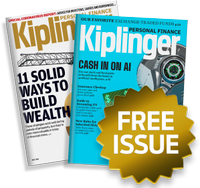How the Rich Can Save $100,000 Tax-Free for Retirement Every Year
Pensions are dead, right? Not if you are self-employed with cash to sock away.

Let me start by saying that I love the 401(k) plan. It’s the single best wealth accumulation vehicle available to the vast majority of Americans. At today’s contribution limits, you can defer up to $18,000 of income — and $24,000 if you’re 50 or older — tax free. And many companies offer corporate matches dollar for dollar (most companies match the first 20-60% you save.)
That’s great for middle-class Americans, and many can contribute the maximum allowed with a little bit of discipline. But if you have an annual income of $500,000 or more, that amounts to a paltry savings rate of less than 4%. Any savings above that amount would be subject to punishingly high taxes…and even the dreaded Obamacare surcharge.
Well, I have good news. If you earn a high income and own your own business (or are paid as a 1099 contractor), you have vastly superior savings options at your disposal. If done right, you can save well over $100,000 per year in tax-sheltered accounts.
From just $107.88 $24.99 for Kiplinger Personal Finance
Be a smarter, better informed investor.

Sign up for Kiplinger’s Free Newsletters
Profit and prosper with the best of expert advice on investing, taxes, retirement, personal finance and more - straight to your e-mail.
Profit and prosper with the best of expert advice - straight to your e-mail.
This strategy is designed for the self-employed, but it can also work if you get a paycheck but also earn additional income from a side business or additional contract income. A lot of doctors and consultants would fall under this umbrella.
We all know that the traditional defined-benefit pension is dead. The days when your employer guaranteed you an income for life are now something we read about mostly in history books.
Well, that might be true for corporate plans. But there is nothing stopping you from starting your pension for yourself and your spouse.
The One-Man Pension
The best retirement savings strategy is actually a combination of two separate vehicles:
1. An Individual 401(k) plan, which consists of regular salary deferral and additional profit sharing based on your company’s profit for the year.
2. A cash-balance, defined-benefit pension plan.
I’ll tackle the Individual (“Solo”) 401(k) plan first. Most investors consider a Solo 401(k) plan to be more or less interchangeable with a SEP IRA.
They’re wrong.
While both plans max out at $53,000 per year in contributions, the Solo 401(k) allows for front loading. Let’s look at an example. Let’s say your business earns $100,000 in net income. With a SEP IRA, you can contribute 20%, or $20,000, tax deferred. This is a profit-sharing contribution made on your behalf by your employer…which happens to be you.
With the Solo 401(k), you can make that same profit-sharing contribution of $20,000. But you can also defer $18,000 of salary, for a total of $38,000.
Of course, we’re talking about high-income earners, and both the Solo 401(k) and the SEP IRA max out at $53,000 on incomes of $265,000.
So, if you earn $265,000 or more, the SEP IRA and Solo 401(k) are interchangeable, right?
Wrong!
If you save via a Solo 401(k), you are also eligible to contribute to a defined-benefit plan. If you save via a SEP IRA, you cannot.
This brings me to the second prong of the retirement plan, the single-person defined-benefit plan.
Yes, you can actually make a traditional pension plan…for yourself. There are administrative fees involved, and you’ll want to hire a professional to draft the plan documents and monitor compliance. But doing all of this opens the door to massively increasing your retirement savings if you can afford it.
Annual contribution levels here depend on your age and other actuarial assumptions, but the chart below shows how they shake out. The contribution limits depend on two main variables: age and income. That’s very different from IRAs/401(k)s, so it takes some getting used to. These are sometimes (though not always -- see a list of exceptions here) insured by the Pension Benefit Guaranty Corporation.

Putting It All Together
Combining the Solo 401(k) with the cash-balance, defined-benefit plan is complicated, so I can’t stress enough the importance of hiring a knowledgeable pro to set it up correctly. But here are the basics.
Normally, you can contribute $18,000 in salary deferral and 20% of profits to a Solo 401(k) plan, up to a maximum of $53,000. But if you also contribute to a cash-balance pension plan, your profit-sharing percentage gets bumped from 20% to 6%. That effectively drops your $53,000 contribution to $33,900 if you’re under 50 and $39,900 if you’re 50 or older.
But here’s where it gets fun. If you’re 65 years old, your combined contribution to the Solo 401(k) and cash-balance pension is a whopping $284,400 ($244,500 cash balance + $39,900 401(k) plan). The numbers get smaller the younger you are, but at age 35 you can still contribute a not-too-shabby $102,200. (Breaking out the math, this is $18,000 in salary deferral, $15,900 in salary deferral at the maximum 6% rate, and $68,300 in defined-benefit contributions.)
Is There a Downside?
So, stashing away hundreds of thousands of dollars per year sounds pretty great, right? What’s the catch?
Believe it or not, there really isn’t one, assuming you earn a high enough income. This isn’t for everyone. You have to own your own business (or earn significant contract income), and you need to have a high income for this to make sense. If the business has any employees, contributions must also be made for them, which can be very expensive. And there are other costs. Expect to pay $2,000 to $3,000 in administrative expenses. But if you fall under this umbrella -- and if you’re eager to shield some of your savings from the tax man -- this is the best combination I’ve seen.
Charles Lewis Sizemore, CFA, is chief investment officer of the investment firm Sizemore Capital Management and the author of the Sizemore Insights blog.
Profit and prosper with the best of Kiplinger's advice on investing, taxes, retirement, personal finance and much more. Delivered daily. Enter your email in the box and click Sign Me Up.

Charles Lewis Sizemore, CFA is the Chief Investment Officer of Sizemore Capital Management LLC, a registered investment advisor based in Dallas, Texas. Charles is a frequent guest on CNBC, Bloomberg TV and Fox Business News, has been quoted in Barron's Magazine, The Wall Street Journal, and The Washington Post and is a frequent contributor to Yahoo Finance, Forbes Moneybuilder, GuruFocus, MarketWatch and InvestorPlace.com.
-
 Selling Your Haunted House? What You Have to Tell Buyers (and What You Don’t)
Selling Your Haunted House? What You Have to Tell Buyers (and What You Don’t)You don’t need ghosts to spook buyers, sometimes a home’s past is enough. Here’s what sellers should know about disclosure laws, pricing and perception when a property has a haunted history.
-
 CMS Brings Back Furloughed Staff for Open Enrollment Lifeline
CMS Brings Back Furloughed Staff for Open Enrollment LifelineThe government has recalled approximately 3,000 workers to assist with Medicare and ACA Marketplace Open Enrollment.
-
 I'm a Financial Pro: This Is How You Can Guide Your Heirs Through the Great Wealth Transfer
I'm a Financial Pro: This Is How You Can Guide Your Heirs Through the Great Wealth TransferFocus on creating a clear estate plan, communicating your wishes early to avoid family conflict, leaving an ethical will with your values and wisdom and preparing them practically and emotionally.
-
 Social Security Wisdom From a Financial Adviser Receiving Benefits Himself
Social Security Wisdom From a Financial Adviser Receiving Benefits HimselfYou don't know what you don't know, and with Social Security, that can be a costly problem for retirees — one that can last a lifetime.
-
 Take It From a Tax Expert: The True Measure of Your Retirement Readiness Isn't the Size of Your Nest Egg
Take It From a Tax Expert: The True Measure of Your Retirement Readiness Isn't the Size of Your Nest EggA sizable nest egg is a good start, but your plan should include two to five years of basic expenses in conservative, liquid accounts as a buffer against market volatility, inflation and taxes.
-
 Ten Ways Family Offices Can Build Resilience in a Volatile World
Ten Ways Family Offices Can Build Resilience in a Volatile WorldFamily offices are shifting their global investment priorities and goals in the face of uncertainty, volatile markets and the influence of younger generations.
-
 I'm a Wealth Adviser: These Are the Pros and Cons of Alternative Investments in Workplace Retirement Accounts
I'm a Wealth Adviser: These Are the Pros and Cons of Alternative Investments in Workplace Retirement AccountsWhile alternatives offer diversification and higher potential returns, including them in your workplace retirement plan would require careful consideration.
-
 I'm a Financial Planner: If You're Within 10 Years of Retiring, Do This Today
I'm a Financial Planner: If You're Within 10 Years of Retiring, Do This TodayDon't want to run out of money in retirement? You need a retirement plan that accounts for income, market risk, taxes and more. Don't regret putting it off.
-
 Five Keys to Retirement Happiness That Have Nothing to Do With Money
Five Keys to Retirement Happiness That Have Nothing to Do With MoneyConsider how your housing needs will change, what you'll do with your time, maintaining social connections and keeping mentally and physically fit.
-
 Treat Home Equity Like Other Investments in Your Retirement Plan: Look at Its Track Record
Treat Home Equity Like Other Investments in Your Retirement Plan: Look at Its Track RecordHomeowners who are considering using home equity in their retirement plan can analyze it like they do their other investments. Here's how.